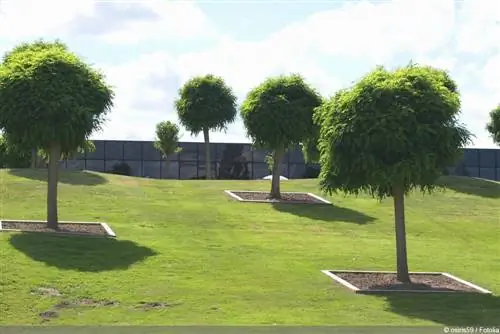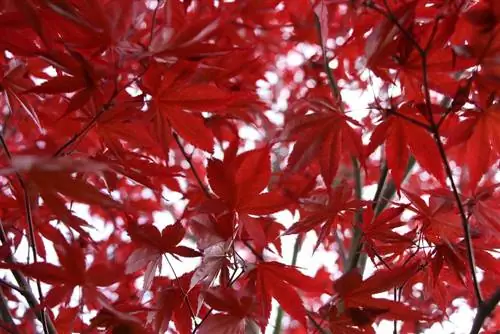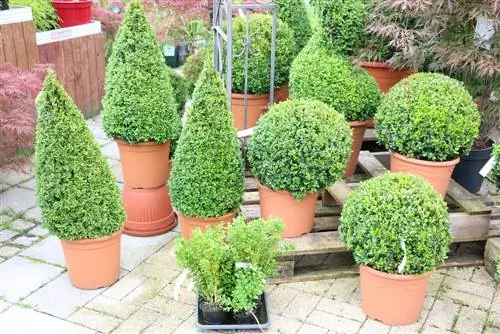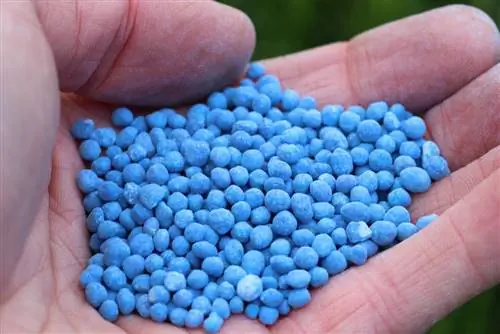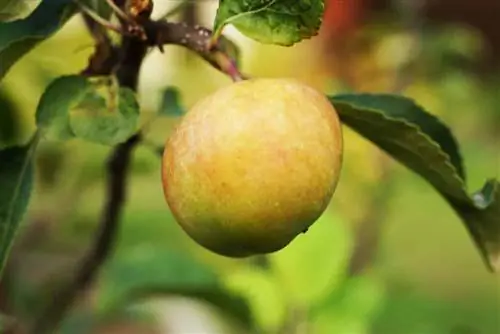- Author admin [email protected].
- Public 2023-12-17 03:39.
- Last modified 2025-06-01 06:48.
There are two groups of ball trees. The crowns of one group are shaped into a ball or brought into the desired shape through an appropriate cut. Those in the second group are varieties whose crowns naturally grow spherical and only rarely need to be cut, such as the ball plane tree. Regular pruning measures are the main part of care.
Planting ball trees
Before planting, you should note that after a few years, ball trees can only be planted with great effort. Accordingly, care must be taken to choose a location where the tree can stand permanently. The final height and width of the crown play a crucial role. As a result, ball trees should always be planted at a sufficient distance from house walls and neighboring properties. Once the right place has been found, you can plant.
- Best planting time in autumn and spring
- Planting in summer is only recommended in exceptional cases
- First dig a sufficiently large planting pit
- Twice as deep and wide as the bale
- Mix excavated soil with organic fertilizer such as horn shavings
- In the main wind direction, drive in a post for stabilization
- Pole should be a maximum of the height of the trunk
- Pour some of the soil mixture into the planting hole
- Insert the ball tree next to the post
- Fill with excavated earth, tamp down soil
- Create a watering edge around the trunk
- Connect the trunk and post using coconut rope
- Finally, water thoroughly
Tip:
When it comes to spherical trees, a distinction is made between deep and shallow roots. With the latter, such as a ball plane tree, there is a risk that some of the roots will come out of the ground and can also damage pipes and cables running in the ground.
Pay attention to root competition
Actually, the trunk area of ball trees is ideal for underplanting. However, the root system also plays an important role here, because the shallow-rooted ones tolerate little root competition. However, there are plants that are suitable for underplanting, for example perennials such as comfrey, fairy flower, creeping spindle, stone seed, fat man and shade sedge as well as various grasses. In contrast, underplanting varieties with heart-shaped root growth, such as ginkgo, trumpet or sweetgum, is much less problematic. Suitable for this purpose include cranesbill, foam blossom, carpet spar, golden strawberry or the Caucasus forget-me-not.
Watering and fertilizing

Good watering is usually only recommended at the time of planting, in the first few weeks afterwards, as well as in persistent heat and drought and long-term container storage. However, water requirements can vary from variety to variety. While some cope well with dryness, others like it evenly moist, which is important to keep in mind. For moisture-loving ball trees, applying a layer of mulch can be helpful. To cover the nutrient requirements, in most cases it is sufficient to add some compost in the spring.
Cutting
Even though ball trees should generally be cared for in the same way as their larger relatives, they differ significantly from one another when it comes to pruning. While some varieties, such as the ball ash, require almost no pruning, others need to be pruned more frequently and regularly. This primarily serves to prevent baldness. Baldness occurs over time due to the dense growth of the crown. Regular thinning and trimming supports the vitality of the tree.
Blending
The best time for thinning is late winter or early spring. There is no heavy pruning. Only old and damaged branches and twigs are removed. You cut right at the base without leaving stubs on the tree. In order to maintain the symmetry of the ball tree, some undamaged branches can also be cut out if necessary. When thinning, as with any other cut, only sufficiently sharp cutting tools should be used. These ensure clean cuts and prevent frayed interfaces, which in turn can be a gateway for germs and pathogens.
Cut to shape
If the crown of a ball tree becomes too large or too wide, it can easily be brought back into shape with the right cut. With some varieties, such as the ball ash or the ball locust, you can even cut back into the old wood. Topiary pruning should be done before new growth appears, preferably in late winter. The need for a topiary should always be decided on a case-by-case basis.
- When pruning, shorten all main branches to 15-20 cm short stubs
- Always cut near a sleeping eye
- Tree sprouts new growth from these eyes
- Re-cut after three to four years
- Short branches that have grown out at the old interfaces
- Cut back to the roots
- For very dense crowns, reduce the number of branches

The ball maple is an exception to topiary. If possible, it should not be cut back too early. If you cut off stronger or older branches in spring, the cuts would bleed profusely. The best time is therefore in August. It is better to avoid pruning branches that are thicker than your thumb.
Tip:
Evergreen standard trunks can be subjected to additional topiary pruning in summer if necessary.
Pruning of damaged areas
Global trees can be damaged to a greater or lesser extent by storms, diseases or pest infestations. Then more radical cutting measures are usually indispensable. To do this, you leave a few well-developed branches standing. They are the basis for the formation of a new crown. All other branches above the grafting point are removed. If this cut is done in late winter, new growth will appear just a few weeks later. Individual damaged branches should be cut off promptly, directly at the base.
Tip:
If the cut was not made directly above the grafting point, a crown may not form. Then you should cut the branches back to the grafting point without leaving any stubs behind.
Wintering
When it comes to overwintering, there is a risk of frost cracks, especially in young ball trees. These are caused by strong temperature fluctuations between day and night. Such temperature differences lead to tension in the bark tissue and the trunk can tear. In the worst case, this can result in the death of the tree in question. This can be counteracted by painting the trunk white, as is done with fruit trees. You can also protect the ball tree by wrapping the trunk with reed or coconut mats, willow or jute.
Diseases
One of the most common diseases that can be dangerous to a ball tree is fungal infestation. Fungi can attack branches and twigs as well as bark and foliage and manifest themselves in the form of discoloration. The cause can be damaged roots or unfavorable soil conditions. Before you reach for the scissors, you should observe the symptoms and only take countermeasures if they worsen significantly. In most cases, however, this can be dispensed with.
Varieties suitable as ball trees
Spherical Maple - Acer platanoides ‘Globosum’
The ball maple is a tree up to 600 cm high and just as wide. Its characteristic spherical crown becomes flat-spherical and weaker in growth as it ages. The upright flower clusters appear before the leaves emerge. The initially light green leaves take on an intense golden yellow to reddish color in autumn. Acer platanoides 'Globosum' loves sunny to partially shaded as well as normal, well-drained garden soil.
Amberbaum - Liquidambar styraciflua ‘Gumball’
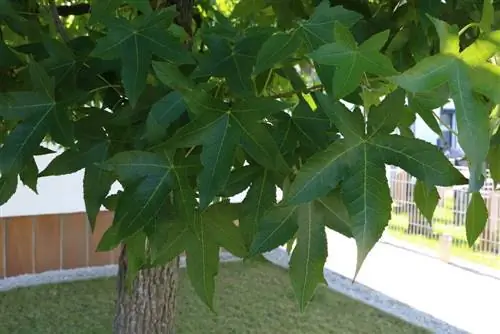
The tree, also known as the dwarf amber tree, is up to 500 cm high and forms a densely branched, almost spherical crown even without cutting, which can be up to 400 cm wide. In autumn it impresses with its magnificent coloring of the leaves. Flowering time is in May. The male flowers are green and grape-like and the female flowers are spherical, spiny capsule fruits. The sweetgum tree likes to grow in sunny locations and in slightly acidic, fertile and fresh to moist soil.
Spherical ash - Fraxinus excelsior ‘Nana’
- Ball ash grows rather slowly
- Up to 600 cm in height and 300 cm in width
- Forms a compact, umbrella-like or irregularly oval crown
- Easy to shape or cut into a ball
- Likes to be sunny, in deep, moist, moderately acidic to alkaline soils
- Fraxinus excelsior impresses with its attractive autumn color
Spherical Field Maple - Acer campestre ‘Nanum’
Acer campestre 'Nanum' is a spherical form of the native field maple. Its crown is spherical, densely leafy and usually wider than tall when it gets older. It grows up to 700 cm in height and 400 - 700 cm in width. Green-yellow flower spikes appear in May and brown fruits in late summer. The globe maple feels at home in sunny to partially shaded locations and in any good garden soil.
Ball Ginkgo - Ginkgo biloba ‘Mariken’
- Grows up to 150 cm high and wide
- Very slow growing
- Forms a loosely to densely branched, almost spherical to flattened crown
- For a good spherical shape, occasional correction cuts required
- Leaves fan-shaped, leathery, fresh green and extremely decorative
- Ginkgo biloba 'Mariken' thrives in sunny to partially shaded locations
- Prefers moist, nutrient-rich, sandy and humus-rich soils
Globe cherry - Prunus fruticosa ‘Globosa’
The ball cherry, also known as steppe or dwarf cherry, grows very slowly, with a densely branched, spherical crown that is up to 400 cm high and wide. Prunus fruticosa 'Globosa' impresses with dark green foliage that turns yellow-orange in autumn, bright white flowers in April/May and, rarely, small sour cherries. The location should be sunny to partially shaded and the soil should be fresh, nutritious and rich in lime.
Ball plane tree - Platanus acerifolia ‘Alphons Globe’

The deciduous, winter-hardy ball plane tree is easy to care for and tolerates pruning, with naturally spherical and even growth. Its crown grows up to 400 cm wide. The flower is rather inconspicuous. Platanus acerifolia prefers sunny to shady locations as well as deep and permeable soils. In autumn it produces spherical fruits.
Robinia - Robinia pseudoacacia ‘Umbraculifera’
- Also known as ball acacia
- Develops a dense and highly branched, spherical crown up to 500 cm wide and high
- Pinnate leaves bluish-green on top, light green underneath
- Robinia pseudoacacia 'Umbraculifera' is very cut-tolerant and loves warmth
- Prefers sunny locations as well as loose and nutrient-rich soil
Tip:
Robinia pseudoacacia 'Umbraculifera' is poisonous in all parts of the plant.
Ball swamp oak - Quercus palustris ‘Green Dwarf’
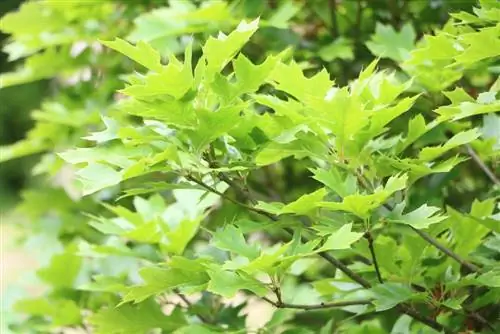
Quercus palustris is a ball tree with a dense, evenly spherical crown and shiny green foliage that turns orange-reddish in autumn. It reaches a height of up to 400 cm and a crown diameter of up to 300 cm. It produces light yellow catkins in May and acorns in autumn. The ball swamp oak loves sunny to partially shaded locations and moderately moist soils.
Ball Trumpet Tree - Catalpa bignonioides ‘Nana’
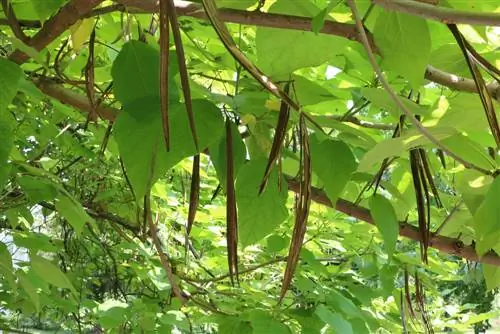
When young, the spherical tree, which is up to 500 cm high and wide, develops a compact, densely branched, spherical crown. With age it becomes flat and round. The initially green, heart-shaped leaves turn light yellow in autumn. The globe trumpet tree thrives in sunny to partially shaded, wind-protected locations and prefers fertile, moist clay soils.

